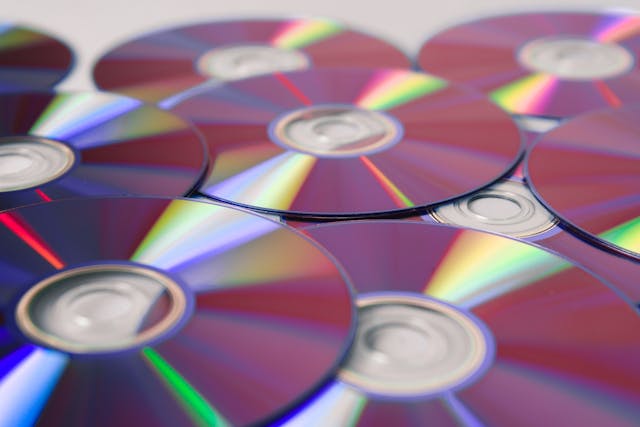
How do CDs and cassettes record information? CDs record information by using pits and bumps, or by using burned colored dye. Cassettes record information by using charged magnetic tape.
There are three types of CDs. There are the CDs you buy prerecorded from the shop, CDs that you burn yourself in your computer, and CDs that you can erase and reburn many times. They use slightly different technology, although the principle is the same. All data that a computer uses has to be rendered into binary. Until we have working quantum computers, all a computer can ever do is know if there is an electrical current flowing through a transistor. If there is a current flowing, this is represented as a 1, and if there is no current flowing, this is represented as a 0. This is how data is recorded on the computer’s hard drive, and it is the way data has to be recorded on a CD. The CDs you buy prerecorded from a shop, record these 1s and 0s by molding pits into the disc.
The disc has three layers. The inner layer and the outer layer are plastic. There is a reflective aluminium layer in the middle. The pits are pressed into the outer plastic layer. When you play the CD, the CD reader has a laser that reflects off the disc as it spins. The reflected light is measured for intensity, and there is a slight difference in the intensity of the light reflected back through the whole plastic layer and the light reflected back through the thinner section where a pit has been cut. The computer reads these differences in intensity and translates them into 1s and 0s. It is not directly that a pit equals a 1, though. The change from pit to flat or flat to pit is a 1. No change is a 0. The pits are about 100 nm deep and 500 nm wide. For comparison, a human hair is about 80,000 nm across.
A disc you can burn yourself and a rewritable disc use slightly different technology. They still use a system that the computer can read as 1s and 0s, but you cannot put pits into a disc with your home computer. Our CD burners (if you still have one, which is very rare these days), burn the disc by using a laser to change the color of a photosensitive dye. The CD has layers, with a reflective layer in the middle again and the photosensitive dye at the top. When you burn data, the laser rapidly switches on and off, and each time it is on it heats the photosensitive dye, changing its color and making these areas less reflective. When the disc is read, the different colors of the dye cause a different intensity in the reflected light, which the computer can read as 1s and 0s.
A rewritable CD uses the same principle as this, but it uses a metal alloy instead of a dye. The metal alloy has a crystalline structure when it is cool. When the laser heats the metal alloy, it melts, and the crystalline structure changes to an amorphous form, which has no clear shape. The reflectivity of the crystalline structure and the amorphous structure are different, and the computer can read these a 1s and 0s. When you need to reuse the disc, the laser goes round and heats the metal alloy to its crystallization point, which is lower than its melting point. That resets the metal alloy, ready to be recorded over again.
A cassette uses a similar principle, but in a much more analog way. A cassette tape has a long reel of polyester plastic tape with a magnetic coating on it. The magnetic coating used to be ferric oxide, which is basically rust. Later cassettes used chromium dioxide, and then cobalt with iron oxide absorbed into it. The only property that these materials needed to have was to be able to be magnetized. When information was recorded onto a cassette, the recorder translated sound or information into electrical signals that were magnetized onto the tape. The recorder had an electromagnet, and when current was applied, it created a varying magnetic field, which was recorded on the magnetic tape. When the tape was played back, the magnetic field induces a voltage in the reader, which is translated into an electrical signal that could be read, or played through speakers if it was an audio cassette. Both cassettes and CDs have been replaced by digital technology, in part because they neither last very long. Although the same could be said about digital files, because formats constantly change. And this is what I learned today.
Sources
https://en.wikipedia.org/wiki/Compact_disc
https://global.canon/en/technology/s_labo/light/003/06.html
https://electronics.howstuffworks.com/gadgets/audio-music/cassette.htm
https://en.wikipedia.org/wiki/Cassette_tape
https://legacybox.com/blogs/analog/how-do-audio-cassettes-work
Photo by Matias Mango: https://www.pexels.com/photo/compact-discs-in-close-up-view-4734714/
